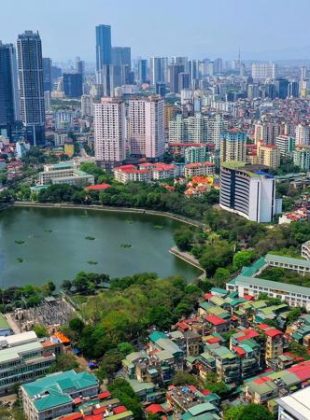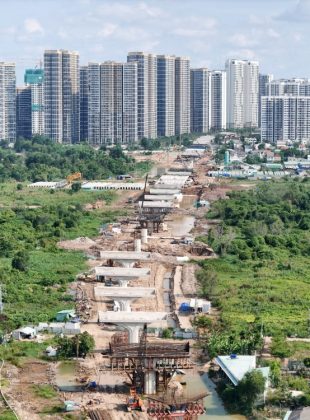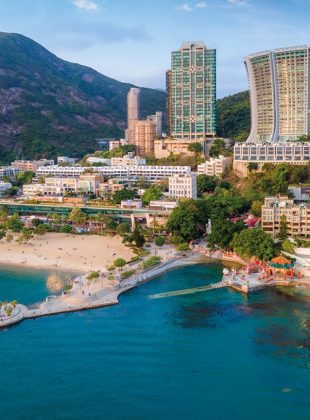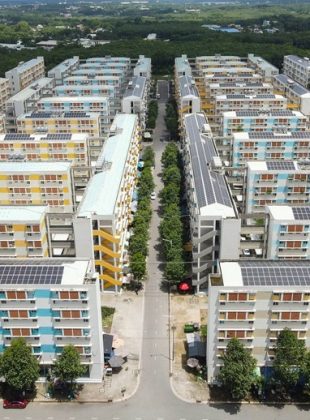Vietnamese history only goes back about 300 years in the southern delta, the first hundred of which was spent clearing and settling much of the region.
Today, the oldest remaining structures are between 160 and 170 years old. Miraculously, they’ve survived American warplanes, and artillery and postwar austerity.
But they are crumbling, nonetheless.
 Photo : A century-old governor’s palace in Long An Province, before being demolished (left) by the provincial government, who then constructed a new structure, roughly modeled on the same design (right).
Photo : A century-old governor’s palace in Long An Province, before being demolished (left) by the provincial government, who then constructed a new structure, roughly modeled on the same design (right).
Alluvial soil, tropical humidity and a host of pernicious insects have harried the buildings since their creation.
But apathy poses the greatest threat of all.
Modernization, regional poverty and sticky application procedures for securing historical status have thrown up numerous obstacles to the preservation of these historic buildings.
Duong Hung Dung, head of the Department of Relic Management at the Tien Giang Provincial Museum said that local residents have little incentive to pursue historical recognition for their property.
To get funds to restore private home, individuals must first have their property acknowledged as a historic-cultural relic. Attaining this status is a lengthy process involving a lot of paperwork.
“[The government] cannot push them,” Dung said. “The whole process depends on people’s willingness to participate. So far, only families whose houses are in areas lucrative for tourism care to restore their property – so they can earn from welcoming travelers looking for home-stays and an authentic experience.”
Those who have nothing to do with tourism don’t care about restoring their homes, he told Thanh Nien Weekly. “It takes between US$50,000-100,000 to restore an old house. That is too much for both the people and the government because Tien Giang is a poor area.”
Beyond the economics of the problem, Dung said he’s seeing an increasing desire among locals to live in modern homes. They would rather rebuild and renovate their homes than enter into the lengthy process of restoration.
“All we can do, for now, is provide advice about how to maintain such buildings and what materials to use,” Dung said.
The poverty of the region and its residents has left those interested in preservation with some tough choices.
Under most provincial authorities here, there are two types of historical structures – wartime relics and those that pertain to the general culture and history of the community.
Dung claimed that in Tien Giang, wartime relics are now the lowest priority.
Long An Province has the fewest and most neglected historical buildings in the region. During the August Revolution in 1945 and subsequent armed struggle against the French, the provincial government operated out of a house in the center of Tan An Town.
The century-old house was known as Dinh Tong Than, or “provincial governor Than’s palace.”
Rather than maintaining the structure, the provincial government demolished it and constructed a new one, roughly modeled on the same design.
At the same time, the province’s former colonial headquarters was remodeled into an office for the provincial People’s Committee.
The once gorgeous old homes in Chau Thanh District, featured in the popular television series Nang Huong (Huong Lady) 15 years ago, have been reduced to rubble.
In addition, reminders of the province’s colonial legacy have largely been dismantled, destroyed or altogether ignored.
In Long An, people removed two iron bridges built by the Eiffel Construction Company in 1886 for the Saigon-My Tho train route, though not so long ago, they had buzzed with local motorbike and bicycle traffic.
Tien Giang Province has the greatest number of old architectural buildings in the area. A 2002 study by the Japan International Cooperation Agency found that there are 350 old structures in the province of which almost two-thirds remain in Go Cong Town.
As Kinh settlers migrated south into the delta regions, many established homes on the stable, elevated ground around Go Cong. It remains something of a tourist destination and is often visited for its famed mausoleum – crafted by carpenters from Hue.
However, most old houses here are being seriously degraded and are disappearing rapidly.
Dung, of the Provincial Museum says that today there are just 300 homes dating from the 19th and 20th centuries. Of these structures, only one has completed the process of being recognized as a historic-cultural relic.
According to a museum staff at Go Cong, just 10 years ago the town was full of historic buildings along Phan Boi Chau and Ly Tu Trong streets. Today, only a few remain and locals have lost the idea of the heart of their community being an “old town.”
Writer Mac Tuyen, who co-filmed Nang Huong, has pushed for the restoration of the “Palace of Go Cong Province,” a 110-year-old house in Dai Dien Commune, Thanh Phu District, Ben Tre Province.
The oldest house in the delta, he stressed, is on the verge of total collapse.
In order to secure money for restoration, the house must be acknowledged as a national historical-cultural relic. In 2002, the residents of the property applied for historic-cultural relic status. The process has stalled numerous times due to infighting among the home’s inhabitants, sketchy architectural schematics, and the tedious task of describing every object inside the house.
Eight years later, the Ben Tre Museum has only sent a staff to spray the house for termites.
Reported by Ky Quan – Phuong Anh













